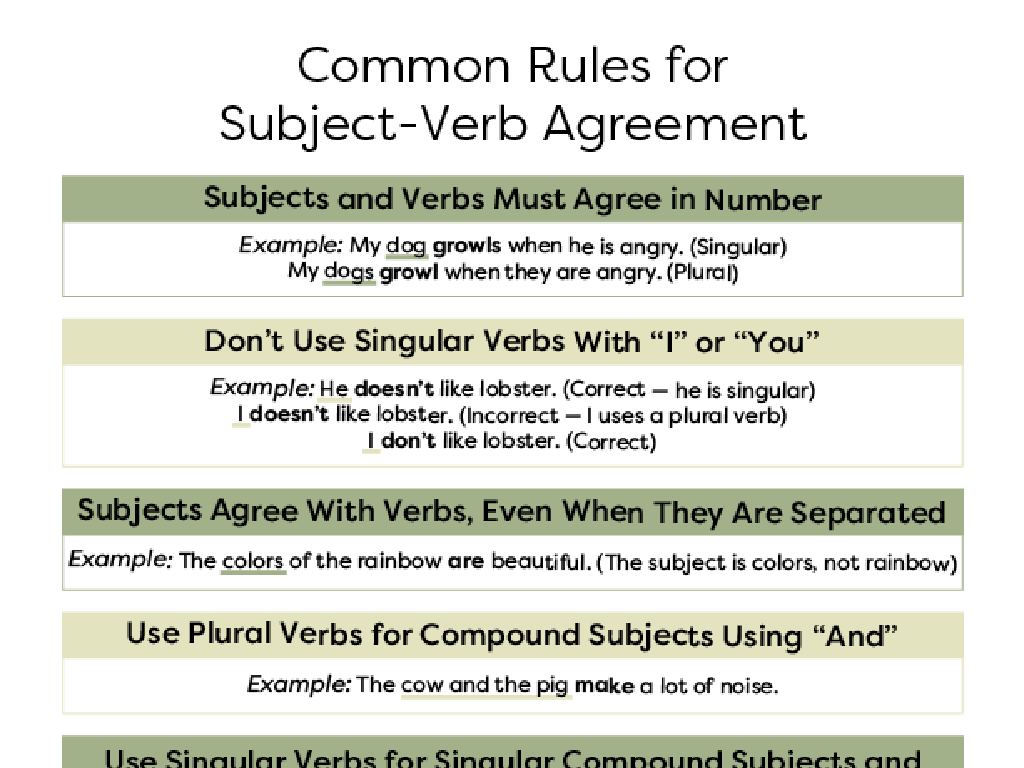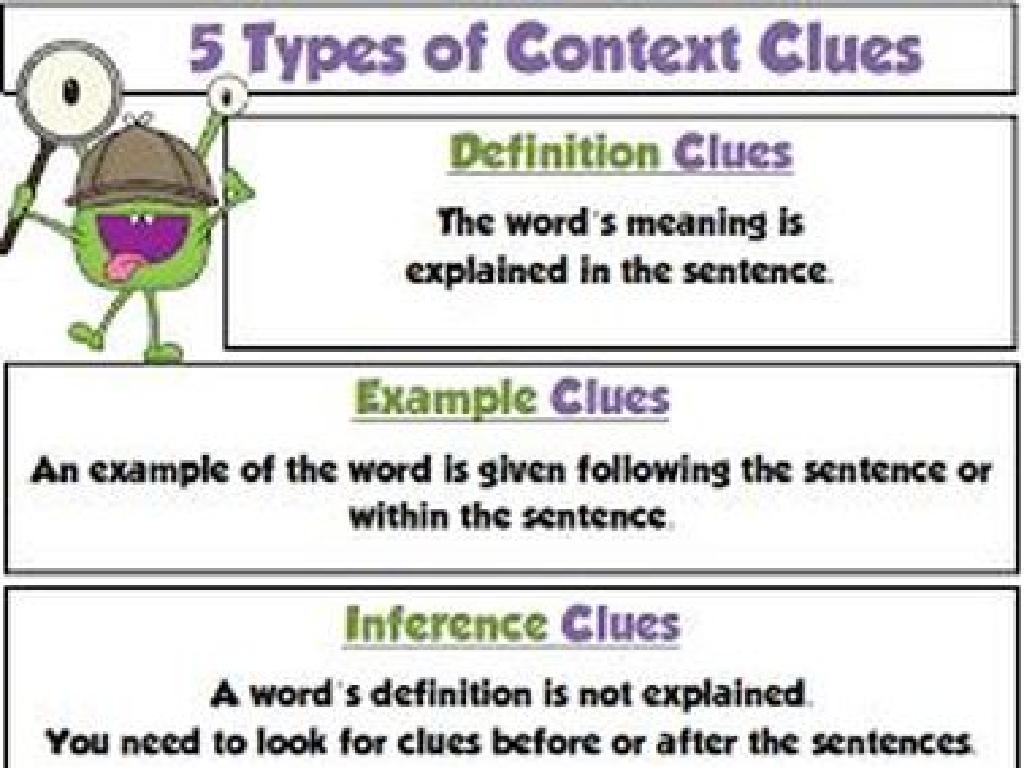Estimate Sums And Differences Of Mixed Numbers
Subject: Math
Grade: Sixth grade
Topic: Add And Subtract Fractions
Please LOG IN to download the presentation. Access is available to registered users only.
View More Content
Estimating Sums & Differences with Mixed Numbers
– What is estimation?
– Estimation: Approximating numbers to make calculations easier.
– The value of estimation skills
– Estimation helps in making quick & reasonable number judgments.
– Estimating with mixed numbers
– Use rounding to estimate sums and differences of mixed numbers.
– Today’s lesson overview
|
This slide introduces the concept of estimation, which is a critical skill in mathematics, especially when dealing with mixed numbers. Estimation allows students to make quick, yet reasonable judgments about sums and differences without needing an exact calculation. Emphasize the importance of estimation in everyday life, such as in shopping or cooking. Today’s lesson will focus on teaching students how to round mixed numbers to the nearest whole number to estimate sums and differences, providing a foundation for more complex arithmetic operations. Encourage students to think about times when they have used estimation outside of school to make the concept more relatable.
Estimating Sums and Differences with Mixed Numbers
– Understanding mixed numbers
– A whole number combined with a fraction, like 2 1/2
– Real-life examples of mixed numbers
– Used in cooking, construction, and time tracking
– Converting to improper fractions
– Multiply the whole number by the denominator, add the numerator
– Estimation techniques
– Round mixed numbers to nearest whole number for quick estimates
|
This slide aims to review the concept of mixed numbers, which are numbers consisting of an integer and a fraction. Students should understand that mixed numbers are used in various real-life situations, such as measuring ingredients for a recipe or determining the length of an object. Converting mixed numbers to improper fractions is a crucial skill for performing mathematical operations. To estimate sums and differences, students can round mixed numbers to the nearest whole number, simplifying calculations. Encourage students to practice these conversions and estimations with examples from everyday life to reinforce their understanding.
Estimating Sums with Mixed Numbers
– Round mixed numbers to whole
– Round 3 1/2 to 4 and 4 2/3 to 5
– Add rounded numbers for sum
– After rounding, add 4 + 5 to estimate
– Example: 3 1/2 + 4 2/3 estimate
– Estimated sum of 3 1/2 and 4 2/3 is about 9
– Practice estimation accuracy
|
This slide introduces students to the concept of estimating sums of mixed numbers by rounding them to the nearest whole number. Start by explaining the process of rounding mixed numbers, then demonstrate how to add these rounded numbers to find an estimated sum. Use the example of 3 1/2 and 4 2/3 to show the practical application of this method. After rounding to the nearest whole numbers, 4 and 5 respectively, students can easily add them to estimate the sum as 9. Encourage students to practice this technique with different mixed numbers to improve their estimation skills and speed in solving problems.
Estimating Differences with Mixed Numbers
– Round mixed numbers for subtraction
– Round to the nearest whole number: 8 – 3
– Subtract the rounded numbers
– Perform subtraction with whole numbers: 8 – 3 = 5
– Example: 7 5/8 – 3 1/4 estimate
– Estimated difference is about 4 1/2
|
This slide aims to teach students how to estimate the difference between mixed numbers by rounding them to the nearest whole number before subtracting. Start by rounding each mixed number to its nearest whole number, then subtract these whole numbers to get an estimated difference. For example, to estimate the difference between 7 5/8 and 3 1/4, round 7 5/8 up to 8 and 3 1/4 down to 3, then subtract 3 from 8 to estimate the difference as 5. However, considering the fractions, the estimated difference is closer to 4 1/2. Encourage students to practice this method with various mixed numbers to become comfortable with estimation, which is a valuable skill in both academic and real-life scenarios.
Estimating Sums and Differences
– Estimations can differ
– Estimations vary based on rounding technique and number sense.
– Rounding numbers methods
– Round up or down to the nearest whole, tenth, or hundredth.
– Rounding impacts estimates
– The way we round affects how close our estimate is to the exact answer.
– Range of acceptable estimates
– Estimates within a small range of the exact answer are usually acceptable.
|
This slide aims to explain why different estimation methods can lead to varying results when dealing with mixed numbers. Emphasize the importance of understanding different rounding techniques, such as rounding to the nearest whole number or to a specific decimal place, and how these choices impact the accuracy of the final estimation. Discuss with students that while estimates are not exact, they should fall within an acceptable range of the actual value. Provide examples of acceptable ranges for different types of problems to give students a concrete understanding of the concept.
Estimating Sums and Differences
– Practice estimation with a partner
– Solve mixed number problems
– Use rounding to estimate sums and differences
– Discuss your estimation strategy
– How did you decide to round the numbers?
– Share results with the class
|
This slide is designed to engage students in a collaborative activity where they will work in pairs to practice estimating the sums and differences of mixed numbers. Provide a set of practice problems for the students to work on together. Encourage them to discuss their strategies for rounding mixed numbers to the nearest whole number as a way to estimate. After they have completed the problems, have each pair share their estimates and the reasoning behind their choices with the class. This will help students learn from each other and understand different approaches to estimation. As a teacher, be prepared to offer guidance on rounding rules and to facilitate the discussion.
Class Activity: Estimation Relay
– Form competitive estimation teams
– Each member solves one estimation problem
– Use mixed numbers to estimate sums and differences
– Pass the problem to the next teammate
– Team with closest estimates wins
– Accuracy is key! Closest to the actual sum or difference
|
This activity is designed to make learning about estimation with mixed numbers interactive and fun. Divide the class into small teams, and provide each team with a set of estimation problems involving sums and differences of mixed numbers. Each student in the team should solve one problem before passing the worksheet to the next member. The goal is to have the most accurate estimates compared to the actual sums or differences. This will help students practice their estimation skills and understand the importance of accuracy in math. Possible variations of the activity could include timed rounds, bonus points for speed, or additional challenges for mixed numbers with larger denominators.
Estimation Mastery & Homework
– Recap: Estimating with mixed numbers
– Review how to round mixed numbers and estimate their sum/difference
– Estimation’s role in daily life
– Useful for quick calculations in shopping, cooking, etc.
– Homework: Estimation worksheet
– Practice makes perfect
– Complete the provided worksheet to reinforce today’s lesson
|
This slide aims to consolidate the students’ understanding of estimating sums and differences of mixed numbers. Begin with a brief recap of the key points from the lesson, emphasizing the rounding of mixed numbers to the nearest whole number for quick estimation. Highlight the practical applications of estimation in everyday scenarios such as budgeting or measuring ingredients. Assign the estimation worksheet for homework to provide students with additional practice, ensuring they apply the concepts learned in class. Encourage them to attempt the worksheet independently, reinforcing their estimation skills and preparing them for real-life applications.






